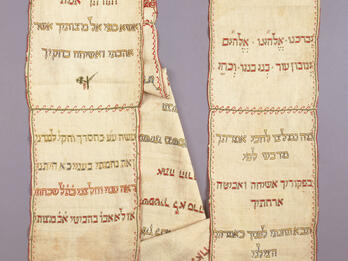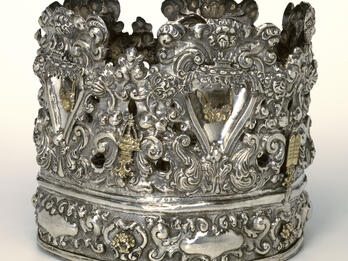Tekhine imohos (Women’s Supplication of the Matriarchs)
Leah Horowitz
Mid–18th Century
Riboyne shel oylem, Almighty God, You created heaven and earth and all creatures with great compassion within six days and with only ten words. And on the seventh day, which is shabes koydesh, You rested from Your work. And You also commanded Your beloved people, yisro’el, that they too, should rest on shabes koydesh from work, and also refrain…
Creator Bio
Leah Horowitz
Sarah Rebecca Rachel Leah (Sore Rivke Rokhl Leye) was born to Reyzl bat Heshel and R. Jacob Yukil Horowitz (1680–1755, of the well-known Horowitz family) in Bolechów, Poland. Most information about Leah, as she is often known (though sometimes as Sore), comes from Ber of Bolechów’s Hebrew memoir, which describes her as “famous” and very learned; she frequently helped him, a young student of her first husband, with his Talmud studies. Leah’s erudition is evident in her Tekhine imahos (Women’s Supplication of the Matriarchs), which has talmudic, halakhic, and kabbalistic citations, including material from the Zohar. In 1742, Leah moved to Glogau, eventually settling in Krasny (Ukraine) with her second husband, R. Shabbetai ha-Kohen Rappaport. Leah’s tekhine was printed in many editions with Yiddish summaries of her Hebrew introduction and Aramaic piyyut (liturgical poem) included in the original; these were generally absent in later printings likely because most Ashkenazic women could not read these languages.
Related Guide
Early Modern Rabbis and Intellectuals on the Move
Carrying books and knowledge, itinerant rabbis and scholars traveled between communities, facilitating cultural exchange.
Related Guide
Early Modern Jewish Languages
As Ashkenazi and Sephardi Jews migrated eastward, Yiddish and Ladino emerged as distinct languages. Both languages developed literary traditions, as print became more widespread.
Related Guide
Early Modern Spiritual Ideologies
Early modern Jewish spiritual life encompassed diverse elements, including theology, ethics, liturgy, and messianism.
This trilingual text—Hebrew, Aramaic, and Yiddish—written by a woman for a female audience is rather anomalous for this period. The Hebrew introduction emphasizes the women’s prayer, emphasizing the spiritual power of women who pray for the Shekhinah and admonishing them to attend services thrice daily. It also includes a rejoinder to women to heed their husbands and a Hebrew prayer for the New Moon. The Yiddish paraphrase of the Aramaic piyyut (liturgical poem), is essentially the same plea to God for redemption on the merits of the matriarchs, but without the kabbalistic references that would have been inaccessible to most of this text’s Ashkenazic female audience.
You may also like

Torah Binder (Italy)
Tekhine (Women’s Supplication): For a Pregnant Woman
Prayer
Father, King
A Song of the Ten Commandments



